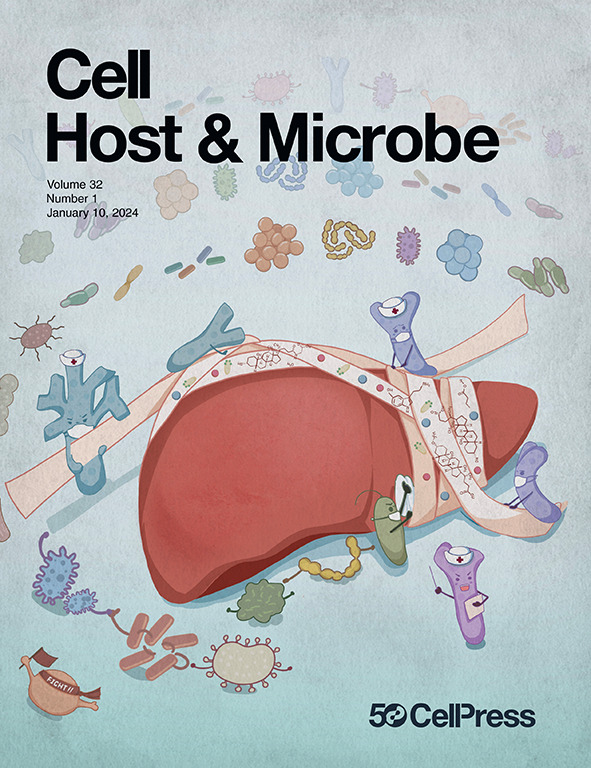同居促进微生物组的转变,促进异黄酮的转化,以改善肝损伤
IF 20.6
1区 医学
Q1 MICROBIOLOGY
引用次数: 0
摘要
对乙酰氨基酚的过度使用是急性肝损伤(ALI)的主要原因。尽管ALI与微生物组组成的个体间差异有关,但其机制尚不清楚。我们证明了肠道菌群在雄性和雌性小鼠之间的水平传播会影响ALI,并确定了微梭菌介导的异黄酮转化是ALI严重程度的决定因素。微梭菌与细菌β-半乳糖苷酶共存时增加,促进异黄酮生物茶素a (Bio-A)的肠道吸收。小梭菌单定殖降低对乙酰氨基酚过量后ALI的严重程度。基因或化学介导的β-半乳糖苷酶抑制阻断了Bio-A的释放,并否定了微褐霉的肝保护作用。Bio-A直接结合丙酮酸羧化酶(PC)和丙酰辅酶a羧化酶亚基α (PCCA),增加三羧酸循环,促进肝细胞中保护性谷胱甘肽的合成。此外,免疫组织化学分析显示肝衰竭(LF)患者的肝脏PC和PCCA表达降低。这些发现强调了微生物组组成对ALI的影响以及微生物异黄酮吸收减轻ALI严重程度的能力。本文章由计算机程序翻译,如有差异,请以英文原文为准。

Cohabitation facilitates microbiome shifts that promote isoflavone transformation to ameliorate liver injury
Acetaminophen overuse is a leading cause of acute liver injury (ALI). Although ALI is linked to inter-individual differences in microbiome composition, the mechanisms remain unclear. We demonstrate that horizontal transmission of gut microbiota between male and female mice impacts ALI and identify Rikenella microfusus-mediated isoflavone transformation as determinants of ALI severity. R. microfusus increases upon cohabitation with bacterial β-galactosidase enhancing intestinal absorption of isoflavone biochanin-A (Bio-A). R. microfusus mono-colonization reduced ALI severity following acetaminophen overdose. Genetic or chemical-mediated inhibition of β-galactosidase blocked Bio-A release and negated the hepatoprotective effects of R. microfusus. Bio-A directly binds to pyruvate carboxylase (PC) and propionyl-CoA carboxylase subunit alpha (PCCA), augmenting the tricarboxylic acid cycle and promoting protective glutathione synthesis in hepatocytes. Additionally, immunohistochemical analysis revealed reduced hepatic PC and PCCA expression in liver failure (LF) patients. These findings highlight the impacts of microbiome composition on ALI and the ability of microbial isoflavone absorption to mitigate ALI severity.
求助全文
通过发布文献求助,成功后即可免费获取论文全文。
去求助
来源期刊

Cell host & microbe
生物-微生物学
CiteScore
45.10
自引率
1.70%
发文量
201
审稿时长
4-8 weeks
期刊介绍:
Cell Host & Microbe is a scientific journal that was launched in March 2007. The journal aims to provide a platform for scientists to exchange ideas and concepts related to the study of microbes and their interaction with host organisms at a molecular, cellular, and immune level. It publishes novel findings on a wide range of microorganisms including bacteria, fungi, parasites, and viruses. The journal focuses on the interface between the microbe and its host, whether the host is a vertebrate, invertebrate, or plant, and whether the microbe is pathogenic, non-pathogenic, or commensal. The integrated study of microbes and their interactions with each other, their host, and the cellular environment they inhabit is a unifying theme of the journal. The published work in Cell Host & Microbe is expected to be of exceptional significance within its field and also of interest to researchers in other areas. In addition to primary research articles, the journal features expert analysis, commentary, and reviews on current topics of interest in the field.
 求助内容:
求助内容: 应助结果提醒方式:
应助结果提醒方式:


